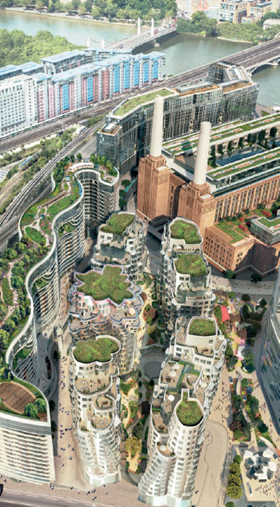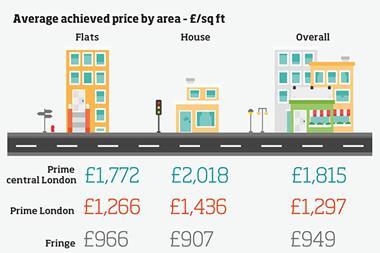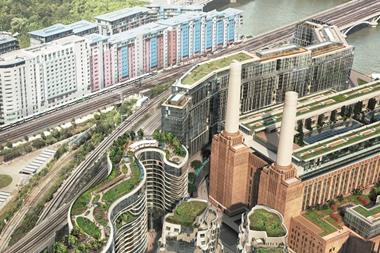As London’s prime resi market slows, Battersea Power Station and the wider Nine Elms area is coming under the spotlight - is the developer worried?

It’s shareholder week, and Rob Tincknell, the man leading the £8bn redevelopment of Battersea Power Station, has barely a minute to spare.
Down at the marketing studio, where a large model of the redeveloped power station dominates the room, he is busy attending to guests.
Outside, the power station itself is surrounded by cranes and is missing all but one of its four iconic chimneys as work on its transformation into a new retail, commercial and residential ‘destination’ proceeds apace.
It’s easy to forget that this was once one of London’s most troublesome brownfield sites, subject to many failed redevelopment visions, some more outlandish than others. When a consortium of Malaysian investors bought the site for £400m in 2012 and announced plans for its transformation, scepticism lingered: could they really pull it off where so many others had failed?
Much of that evaporated when, in early 2013, the developer launched the first phase of the scheme and sold all 865 flats in a few weeks.
But that was then. Now, three years on, the scepticism is returning. Stamp duty hikes, global economic uncertainty, the falling oil price and Brexit fears have created a perfect storm that has hit London’s prime resi market. Buyers at the top end have become scarce and prices are falling.
Developers are now struggling to sell prime flats and are resorting to heavy discounts, or packaging units up and selling them on to institutions.
For the doom-mongers, Battersea - long a London icon - seems primed to become the emblem of a London housing market crash. So is Tincknell worried?
“No, I’m not,” he says, defiantly. “Because I think long term we’ve got a very solid project that is very stable.”
Maybe so, but he felt concerned enough to make an impromptu trip to Mipim last month to talk up the scheme to all who would listen - and he has had his team at the Battersea Power Station Development Company prepare a ‘myth-busting’ crib sheet to try and head off some of the bad press it has been receiving.
‘Nonsense’
This has largely focused on claims that the flats have been bought by speculators, who are now desperately trying to offload them - and that the volume of resales means the prices on unsold flats on the scheme are now being slashed.
Tincknell says this is “nonsense”. Yes, there has been a considerable number of resales on the scheme - he estimates around 10%-15% of the 865 flats in phase one have been reassigned (although, if the 114 flats on sale on Rightmove last week sell, that proportion could rise to around 30%).

But Tincknell says this is the result of lenders’ requirements that developers sell a significant proportion of the scheme off-plan, which tends to attract speculative investors. The developer has set up its own estate agent, which handles many of the resales, and Tincknell claims around 70% are going to UK buyers, who are more likely to be owner-occupiers. “When the investors sell it’s the owner-occupiers who buy because it’s closer to their timeframes,” he says.
“But I’m very thankful to the speculative buyers because without them the development would not have happened.”
Tincknell is also at pains to make clear that no investor has lost money on a resale: while prices on Rightmove may be slashed, the resales are still going through on average around 20% above the original value.
One example of a fl at for resale for £6.5m that was eventually sold for £4.5m was actually originally bought for around £3m, so while the resale price may have been slashed by around 30%, the seller is still pocketing a £1.5m profit.
“I don’t think the fact that people are putting their apartments on the market is a reflection of a mad panic and that people are desperate to exit,” says Tincknell. “A lot of it is just speculative: it costs them nothing to put the apartment on the market at a very strong asking price and if they sell, they’re very happy and can take a bit of a profi t. If they don’t, they will keep it. Either way, I don’t really mind.”
Lights out?
Under the terms of the original sale, an apartment can only be reassigned once before completion, which prevents flats being ‘flipped’ again and again. But with so many speculative investors, isn’t Tincknell worried the buildings won’t be lived in?
“Just because someone is an investor it doesn’t necessarily mean the lights are going to be off - there is also a strong need in London for rental stock,” he counters.
“I would love to have owner-occupiers, but I don’t have a problem with renters - it’s lights off that I don’t want.”
With the off-plan buyers only having paid a 20% deposit, the real acid test for the scheme comes at the end of this year, when owners will move into the first apartments at Circus West and the sales will complete. Despite the clouds hanging over the global economy, Tincknell does not anticipate any defaults. “I have absolutely no fears whatsoever of people not completing on this project,” he says. “It’s a great scheme and there’s loads of growth to come.”

There is no question, however, that sales have slowed. After selling out the first phase in a few weeks, sales on the next two phases have been far more sluggish.
Phase two, the redevelopment of the station itself, was launched with 254 apartments in March 2014. Two years later there are still “around 20” on the market, Tincknell says.
The third phase, a 1,306-home scheme, designed by Foster + Partners and
Frank Gehry, is being built in two parts: the first was launched in October 2014, with an initial tranche of 539 apartments – but 18 months later only 350 have been sold.
Tincknell says only 35 apartments from that launch are now on the market, as a clutch of around 150 apartments are being held back.
“If there is market demand we will release more units, but the market has softened,” he says.
“When we sell the 35 we will probably release some more, but the market is the market, and we don’t need to be chasing sales.”
Tincknell says the developer is offering discounts to drive through some sales, but is not considering bulk sales to institutional investors to shift units, as other London developers are now doing. “There have been discounts – there always have been – but I’m not going to go into how much,” he says.
“But we don’t need to go off and start heavily discounting our apartments because we’re in reasonably good shape. In general, the market is quite challenging – there are fewer buyers around.
“That doesn’t mean we have stopped – we are still selling apartments, but we’re not chasing the market and we’re not worried.”
Not just a resi project
Tincknell can afford to be more sanguine about the state of the resi market, because Battersea is not just a resi project; it will also comprise more than 3m sq ft of commercial space, including 1.2m sq ft of offices and as much retail as Westfield London.
The focus of the scheme is now shifting to the 470,000 sq ft of office space in the power station – an anchor office tenant is expected to be announced in the summer – and the next phases of resi development are some years off.
These include the second, 767-home part of phase three, which includes Gehry’s spectacular ‘Flower’ building and the second half of Foster’s Battersea Roof Garden.
This is not set to start until after the site is handed back by Transport for London (TfL) in 2019, following construction of the Northern line extension.
The launch of those apartments is not expected until 2018 – enough time for the resi market to bounce back.
Beyond that, phase four is in planning, but construction is not due to start until after 2020 – when the site will be handed back by TfL. Tincknell does not expect the timing of these phases to be delayed by market conditions.
“On a long-term project like this, the best way to insulate yourself against the markets’ ebbs and flows is by being properly mixed-use – so when one market ebbs you can concentrate on another,” he says.
“You have to allow for changes that are going to occur through the 15-year life of the project, and if you don’t you’re going to get into trouble. But we’re not delaying anything; let’s be clear about that.”
Battersea may not be entirely insulated from the storm that has hit London’s prime resi market, but nor does it seem too badly battered by it. The real health test will come at the end of this year when the first sales complete.
#Londonhousing debate
Ahead of the vote for the next London mayor, join housing experts from BNP Paribas Real Estate and journalists from Property Week to debate the key housing issues … in 140 characters.
Follow @PropertyWeek and @BNPPRE_UK Thursday 28 April 12pm – 1pm #Londonhousing






























No comments yet